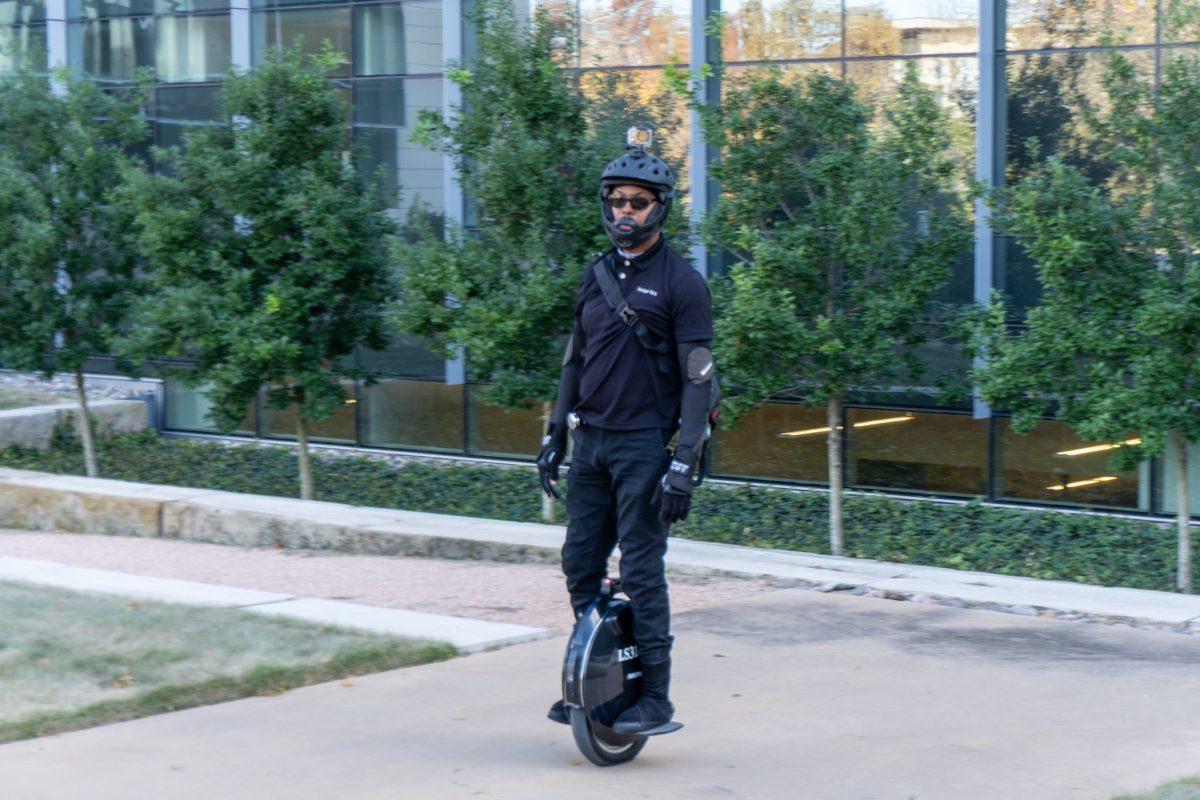A blur of dark safety gear and black rubber are all you see of the rider zooming past pedestrians and weaving between campus streets. As he speeds into the distance, it becomes clear that the man is standing on one wheel.
“When people finally figure it out, I’m usually gone,” said army veteran Lee Hines, who can sometimes be seen riding through campus on his electric unicycle.
Hines began using this transportation and recreational device in January and came across it as an alternative to his foldable electric bike. He started researching electric unicycles after seeing another veteran from Richardson Bike Mart riding his.
“I started out with a folding electric bike because I needed something to exercise (with) and that was portable and I enjoyed it. But even with the portability, it was still 60 pounds and I had to lug it in my SUV, so it just wasn’t convenient,” Hines said. “The electric unicycle is different than the electric bike in mobility, portability and fun. It’s only 45 pounds. I can put it in the backseat of my car (and) I don’t have to lock my bike because I can carry it pretty much anywhere.”
It has helped him manage a disability because he is out every day. Since he rides about 20 miles per day, Hines said he also walks one to two miles every day. Initially, he said his wife was concerned about the safety of this device.
“She was worried at first, but I did all my research,” Hines said. “I’m just a curious person … I’m always looking around the curve, whatever interests me I just kind of go with it, and she supported me.”
The environmental impact of electric unicycles was another benefit of these devices, Hines said.
“The only petroleum this device utilizes is what it is made out of — plastic,” Hines said. “It’s rechargeable, there’s no emission, and I’m not using any fossil fuel to repower it. It’s like a Tesla on one wheel.”
He averages 30 miles per charge on his model, which is made by a company called InMotion. It cost $1,300 and Hines said he purchased $300 worth of safety equipment: a helmet, a rearview mirror, gloves, elbow pads and knee pads. Besides getting a flat tire once and recharging it, Hines said there are no maintenance costs associated with the device.
“It’s over-engineered for safety because it has two computer chips on board, and the gyroscope keeps the device balanced,” Hines said. “In the unlikely incident that my power breaks out or the board breaks out, my second board kicks in to where it won’t make me do a faceplant. It can go a lot faster than 25 miles an hour, but they intentionally have it governed down, so safety is why I went with this device.”
To learn how to ride the vehicle, Hines used Youtube and information from the distributors. It took him about four to six hours to learn how to mount the vehicle, and about three days to get comfortable riding.
“Once you get used to what we call ‘Riding on a magic carpet’ or ‘Jesus walking on water,’ because it’s gliding, it takes 90 days of being out in the environment and keeping your concentration to master the device,” Hines said. “It’s so difficult to lose concentration because if I look a certain way or look at a car, my balance totally changes.”
To help him focus, Hines uses jawbone conducive headphones and has binaural beats playing in addition to his music.
“It’s kind of a cheat because it forces my brain to not be distracted,” Hines said. “At first it is very distracting because you know, people are looking at you and people are honking at you so it takes a very keen sense of concentration.”
The biggest obstacles in order for Hines are motorists, pets off their leashes, pedestrians and cyclists.
“Pedestrians don’t pay attention because they have phones in their face, and earplugs in their ears, so they don’t hear you, don’t see you, then they’ll just walk out in front of you,” Hines said.
People curious about Hines’ device try to stop him every day, and it occurs at least three times daily, but he said he doesn’t pause as often anymore. When he does, he directs them to ewheels.com.
“I’ve seen kids, little three or four years old, get off their scooters and push them aside and tell their mom or dad, ‘I want one of those’,” Hines said. “Anybody who’s looking to get one, please prepare to be an involuntary ambassador because people are going to ask you questions about it.”
Aside from the initial costs, the device is accessible because it requires no insurance, license or registration. It is treated like a bike so riders don’t have to do anything other than learn to ride safely and obey the traffic laws, Hines said.
With about 3,000 miles on his device, Hines said he uses it recreationally and when he goes somewhere in a three to 10-mile radius.
“It’s the ultimate physical therapy, it feels like you’re flying,” Hines said. “I’ve been a motorcycle rider since I was nine years olds, I‘ve ridden horses, I’ve ridden in tanks, I’ve ridden in planes, and without a doubt (the electric unicycle) is the most calming experience … to be able to say I want to move forward and I move forward effortlessly. It is so exhilarating.”







